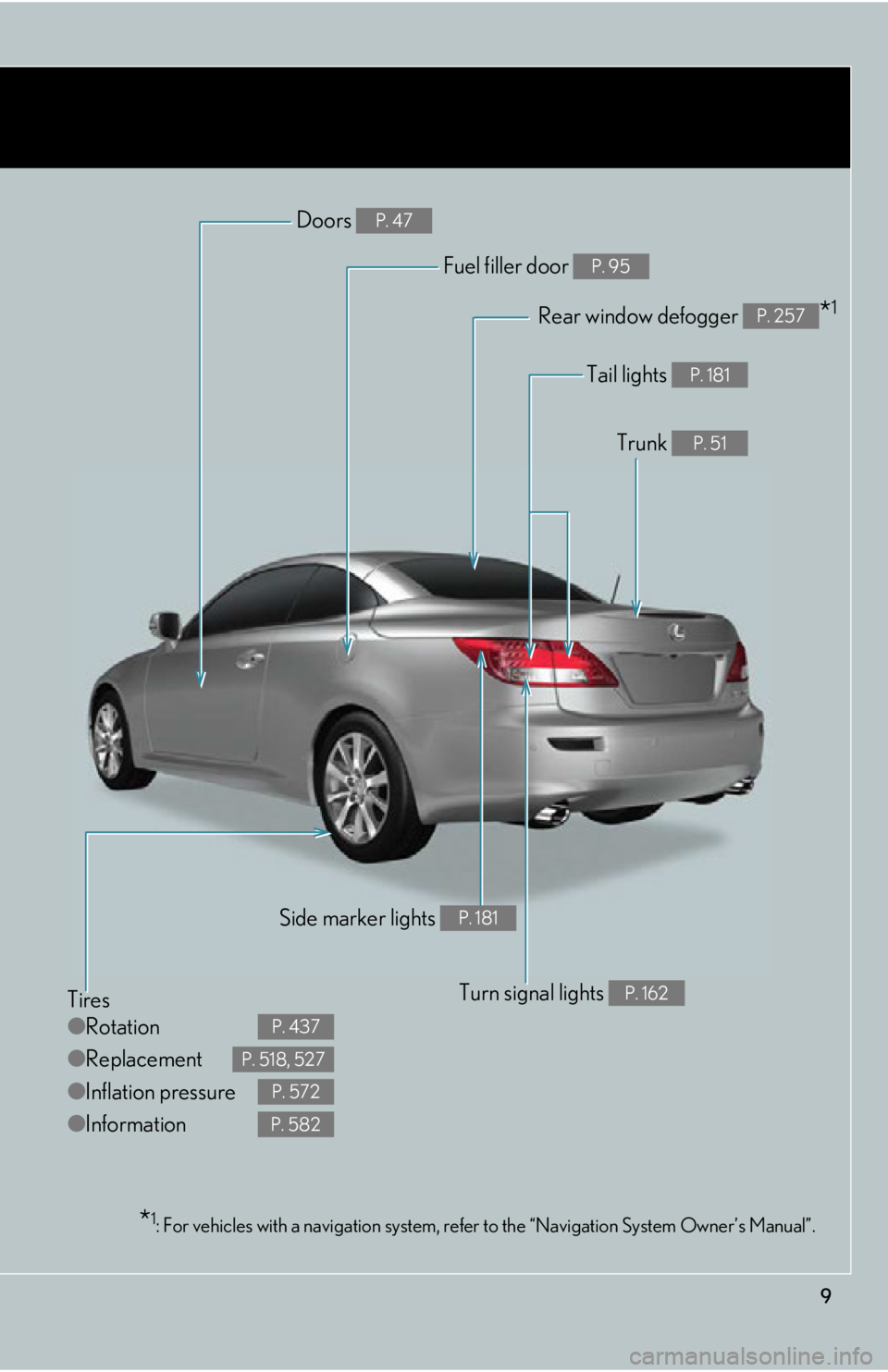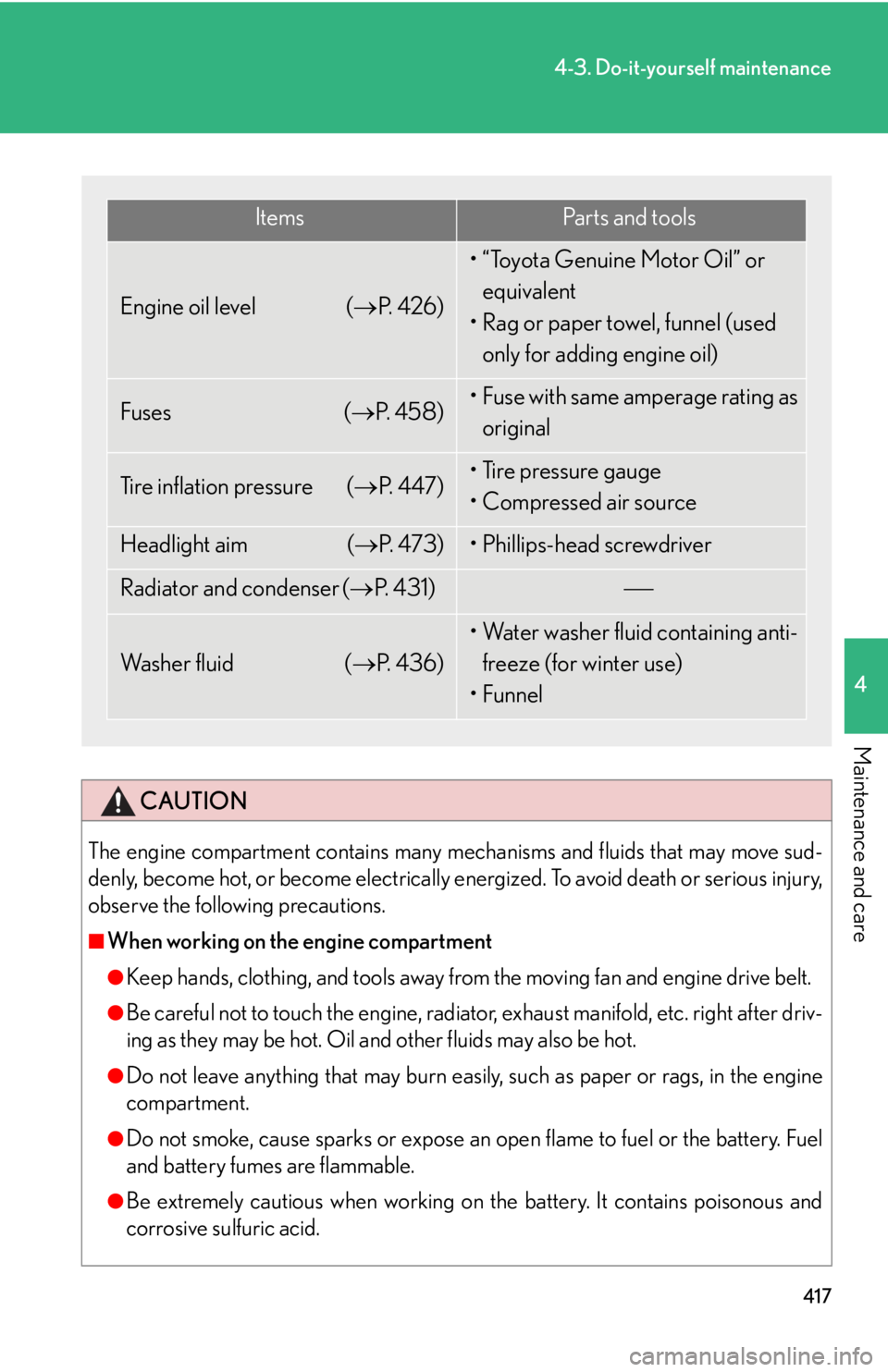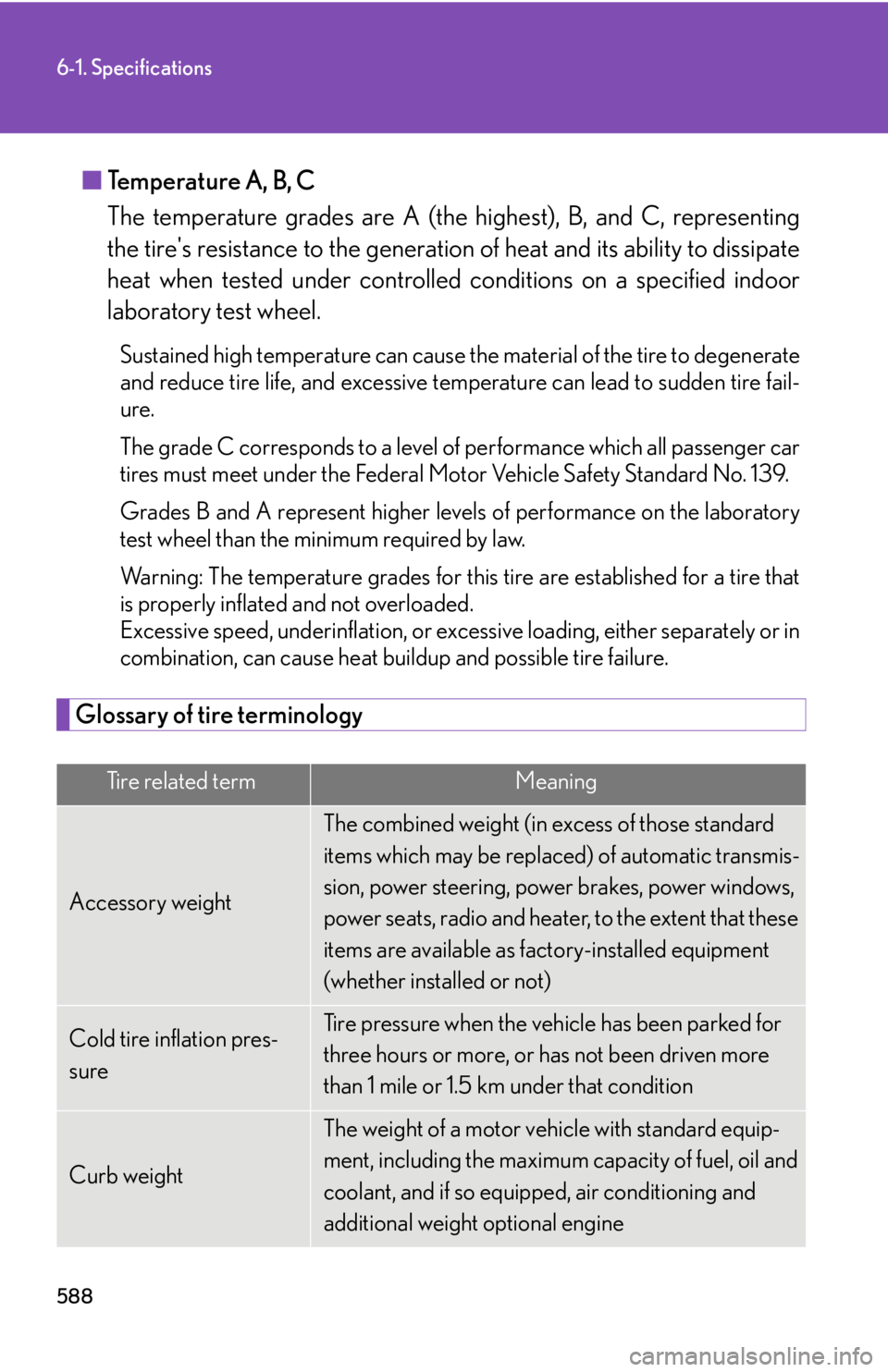fuel pressure Lexus IS250C 2012 Instrument cluster / LEXUS 2012 IS250C,IS350C OWNERS MANUAL (OM53A62U)
[x] Cancel search | Manufacturer: LEXUS, Model Year: 2012, Model line: IS250C, Model: Lexus IS250C 2012Pages: 632, PDF Size: 6.77 MB
Page 9 of 632

9
Tires
●Rotation
● Replacement
● Inflation pressure
● Information
P. 437
P. 518, 527
P. 572
P. 582
Tail lights P. 181
Trunk P. 51
Rear window defogger *1P. 257
Doors P. 47
Fuel filler door P. 95
Turn signal lights P. 162
Side marker lights P. 181
*1: For vehicles with a navigation system, refe r to the “Navigation System Owner’s Manual”.
Page 403 of 632

403
4-1. Maintenance and care
4
Maintenance and care
■Automatic car washes
●Before washing the vehicle, do the following.
•Fold the mirrors back.
• Remove the antenna. (if detachable)
●Brushes used in automatic car washes may scratch the vehicle surface and
harm your vehicle’s paint.
■High pressure car washes
●Do not allow the nozzles of the car wash to come within close proximity of the
windows.
●Before car wash, check that the fuel filler door on your vehicle is closed prop-
erly.
■Aluminum wheels
●Remove any dirt immediately by using a neutral detergent. Do not use hard
brushes or abrasive cleaners. Do not use strong or harsh chemical cleaners.
Use the same mild detergent and wax as used on the paint.
●Do not use detergent on the wheels when they are hot, for example after driving
for long distance in the hot weather.
●Wash detergent from the wheels immediately after use.
■Bumpers
Do not scrub with abrasive cleaners.
■Outside rear view mirror rain -clearing coating (if equipped)
Observe the following precautions in order to retain the rain-clearing properties of
the mirror.
●Clean the mirrors using car shampoo or glass cleaner that does not contain sili-
cone or an abrasive compound, and rinse thoroughly with water.
●Allow the mirrors to be exposed to direct sunlight for 1 to 2 days.
Page 417 of 632

417
4-3. Do-it-yourself maintenance
4
Maintenance and care
CAUTION
The engine compartment contains many mechanisms and fluids that may move sud-
denly, become hot, or become electrically energized. To avoid death or serious injury,
observe the following precautions.
■When working on the engine compartment
●Keep hands, clothing, and tools away from the moving fan and engine drive belt.
●Be careful not to touch the engine, radiator , exhaust manifold, etc. right after driv-
ing as they may be hot. Oil and other fluids may also be hot.
●Do not leave anything that may burn easi ly, such as paper or rags, in the engine
compartment.
●Do not smoke, cause sparks or expose an open flame to fuel or the battery. Fuel
and battery fumes are flammable.
●Be extremely cautious when working on the battery. It contains poisonous and
corrosive sulfuric acid.
ItemsPa r t s a n d t o o l s
Engine oil level ( P. 4 2 6 )
• “Toyota Genuine Motor Oil” or
equivalent
• Rag or paper towel, funnel (used only for adding engine oil)
Fuses ( P. 4 5 8 )• Fuse with same amperage rating as
original
Tire inflation pressure ( P. 4 4 7 )• Tire pressure gauge
• Compressed air source
Headlight aim ( P. 4 7 3 )• Phillips-head screwdriver
Radiator and condenser ( P. 4 3 1 )
Wa s h e r f l u i d ( P. 4 3 6 )
• Water washer fluid containing anti-
freeze (for winter use)
•Funnel
Page 449 of 632

449
4-3. Do-it-yourself maintenance
4
Maintenance and care
■Effects of incorrect tire inflation pressure
Driving with incorrect tire inflation pressure may result in the following:
●Reduced fuel efficiency
●Reduced driving comfort and tire life
●Reduced safety
●Damage to the drive train
If a tire needs frequent refilling, have it checked by your Lexus dealer.
■Instructions for checking tire inflation pressure
When checking tire inflation pressure, observe the following:
●Check only when the tires are cold.
If your vehicle has been parked for at least 3 hours and has not been driven for
more than 1 mile or 1.5 km, you will get an accurate cold tire inflation pressure
reading.
●Always use a tire pressure gauge.
The appearance of the tire can be misleadi ng. In addition, tire inflation pressures
that are even just a few pounds off can degrade ride and handling.
●Do not bleed or reduce tire inflation pressure after driving. It is normal for the
tire inflation pressure to be higher after driving.
●Never exceed the vehicle capacity weight.
Passengers and luggage weight should be placed so that the vehicle is bal-
anced.
Page 499 of 632

5
When trouble arises
499
5-2. Steps to take in an emergency
■If the malfunction indicator lamp comes on while driving
First check the following:
●Is the fuel empty?
If it is, fill the fuel tank immediately.
●Is the fuel tank cap loose?
If it is, tighten it securely.
The lamp will go off after taking several driving trips.
If the lamp does not go off even after several trips, contact your Lexus dealer as
soon as possible.
■Electric power steering system warning light
When the voltage is low or drops, the electric power steering system warning light
may come on.
■Front passenger detection se nsor and passenger seat belt reminder and warning
buzzer
●If luggage is placed on the front passenger seat, the front passenger detection
sensor may cause the warning light to flash and the warning buzzer to sound,
even if a passenger is not sitting in the seat.
●If a cushion is placed on the seat, the sensor may not detect a passenger, and the
warning light may not operate properly.
■When the tire pressure warning light comes on
Check the tire inflation pressure and adjust to the appropriate level. Pressing the
satellite switch does not turn off the tire pressure warning light.
Page 502 of 632

502
5-2. Steps to take in an emergency
CAUTION
■Maintenance of the tires
Each tire, including the spare (if provided), should be checked monthly when cold
and inflated to the inflation pressure re commended by the vehicle manufacturer on
the vehicle placard or tire inflation pressu re label (tire and load information label).
(If your vehicle has tires of a different size than the size indicated on the vehicle
placard or tire inflation pressure label [tire and load information label], you should
determine the proper tire inflation pressure for those tires.)
As an added safety feature, your vehicl e has been equipped with a tire pressure
monitoring system (TPMS-tire pressure warning system) that illuminates a low tire
pressure telltale (tire pressure warning light) when one or more of your tires is sig-
nificantly under-inflated. Accordingly, when the low tire pressure telltale (tire pres-
sure warning light) illuminates, you should stop and check your tires as soon as
possible, and inflate them to the proper pressure. Driving on a significantly under-
inflated tire causes the tire to overheat and can lead to tire failure. Under-inflation
also reduces fuel efficiency and tire tread life, and may affect the vehicle's handling
and stopping ability.
Please note that the TPMS (tire pressure warning system) is not a substitute for
proper tire maintenance, and it is the driv er's responsibility to maintain correct tire
pressure, even if under-inflation has not reached the level to trigger illumination of
the TPMS low tire pressure telltale (tire pressure warning light).
Your vehicle has also been equipped with a TPMS (tire pressure warning system)
malfunction indicator to indicate when th e system is not operating properly. The
TPMS (tire pressure warning system) malfunction indicator is combined with the
low tire pressure telltale (tire pressure warning light). When the system detects a
malfunction, the telltale will flash for approximately one minute and then remain
continuously illuminated. This sequence will continue upon subsequent vehicle
start-ups as long as the malfunction exists . When the malfunction indicator is illumi-
nated, the system may not be able to detect or signal low tire pressure as intended.
TPMS (tire pressure warning system) malfunctions may occur for a variety of rea-
sons, including the installation of replacem ent or alternate tires or wheels on the
vehicle that prevent the TPMS (tire pres sure warning system) from functioning
properly. Always check the TPMS (tire pressure warning system) malfunction tell-
tale after replacing one or more tires or wheels on your vehicle to ensure that the
replacement or alternate tires and wheels allow the TPMS (tire pressure warning
system) to continue to function properly.
Page 588 of 632

588
6-1. Specifications
■Temperature A, B, C
The temperature grades are A (the highest), B, and C, representing
the tire's resistance to the generation of heat and its ability to dissipate
heat when tested under controlled conditions on a specified indoor
laboratory test wheel.
Sustained high temperature can cause the material of the tire to degenerate
and reduce tire life, and excessive temperature can lead to sudden tire fail-
ure.
The grade C corresponds to a level of performance which all passenger car
tires must meet under the Federal Mo tor Vehicle Safety Standard No. 139.
Grades B and A represent higher levels of performance on the laboratory
test wheel than the minimum required by law.
Warning: The temperature grades for this tire are established for a tire that
is properly inflated and not overloaded.
Excessive speed, underinflation, or excess ive loading, either separately or in
combination, can cause heat buildup and possible tire failure.
Glossary of tire terminology
Tire related termMeaning
Accessory weight
The combined weight (in excess of those standard
items which may be replaced) of automatic transmis-
sion, power steering, power brakes, power windows,
power seats, radio and heater, to the extent that these
items are available as factory-installed equipment
(whether installed or not)
Cold tire inflation pres-
sureTire pressure when the vehicle has been parked for
three hours or more, or has not been driven more
than 1 mile or 1.5 km under that condition
Curb weight
The weight of a motor vehicle with standard equip-
ment, including the maximum capacity of fuel, oil and
coolant, and if so equipp ed, air conditioning and
additional weight optional engine
Page 629 of 632

629
Alphabetical index
Warning buzzersBrake system ....................................... 495
Open door .......................................... 497
Seat belt reminder ............................ 497
Warning lights Anti-lock brake system .................. 496
Brake assist system .......................... 496
Brake system ....................................... 495
Charging system ............................... 495
Electric power steering systemwarning light ..................................... 496
Low fuel level....................................... 497
Malfunction indicator lamp .......... 496
Master warning light ........................ 497
Open door ........................................... 497
Pre-collision system ......................... 496
Pretensioners ...................................... 496
Seat belt reminder light .................. 497
SRS airbags .......................................... 496
Tire pressure warning light........................................................ 497
Warning messages Dynamic radar cruise control ...................... 505, 507
Engine oil level .................................... 507
Engine oil maintenance.................. 507
Engine oil pressure........................... 504
Hood ....................................................... 507
Intuitive parking assist ........ 505, 507
Open door ........................................... 507
Parking brake ...................................... 507
Pre-collision system ............ 505, 507
Retractable hardtop ............ 505, 507 Smart access system with
push-button start ............................. 514
Steering lock........................................ 505
Trunk ....................................................... 507
Washer fluid ........................................ 507
Washer Checking ...............................................436
Preparing and checking before winter ....................................238
Switch........................................................ 187
Washing and waxing ...........................402
Weight Cargo capacity ................................... 234
Load limits ............................................. 237
Weight.................................................... 560
Wheels ....................................................... 451
Window glasses ...................................... 82
Window lock switch ...............................83
Windows Power windows ..................................... 82
Rear window defogger................... 257
Washer .................................................... 187
Windshield wiper de-icer..................258
Windshield wipers................................. 187
Wireless remote control key Replacing the battery...................... 456
WMA disc* ............................................. 277W
*: For vehicles with a navigation system, refer to the “Navigation System Owner’s Manual”.
Page 631 of 632

631
What to do if...
A warning light or indicator
light comes onP. 4 9 5If a warning light turns on or a warning
buzzer sounds...
■Warning lights
or or
P. 4 9 5P. 4 9 6
P. 4 9 7
or
P. 4 9 6P. 4 9 7
P. 4 9 7P. 4 9 7
P. 4 9 6P. 4 9 6
P. 4 9 7P. 4 9 6
P. 4 9 5P. 4 9 7
P. 4 9 6
Brake system warning lightMalfunction indicator lamp
“ABS” warning lightDriver’s seat belt reminder
light
Front passenger’s seat belt
reminder light
Low fuel level warning lightMaster warning light
SRS warning lightElectric power steering system
warning light
Open door warning lightPre-collision system warn-
ing light
Charging system warning
lightTire pressure warning light
Slip indicator
Page 632 of 632

632
GAS STATION INFORMATION
Auxiliary catch leverP. 4 1 9Trunk openerP. 5 1Fuel filler door P. 9 5
Hood lock release lever P. 4 1 9Fuel filler door openerP. 9 5Tire inflation pressureP. 5 7 2
Fuel tank capacity
(Reference)17.2 gal. (65 L, 14.3 Imp. gal.)
Fuel typeUnleaded gasoline only P. 96, 563
Cold tire inflation
pressureP. 5 7 2
Engine oil capacity
(Drain and refill
reference)qt. (L, Imp. qt.)
Without filter 6.2 (5.9, 5.2)
With filter 6.6 (6.3, 5.5)
Engine oil typeP. 564